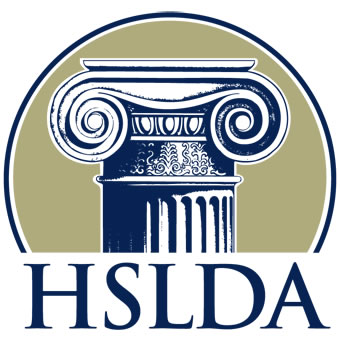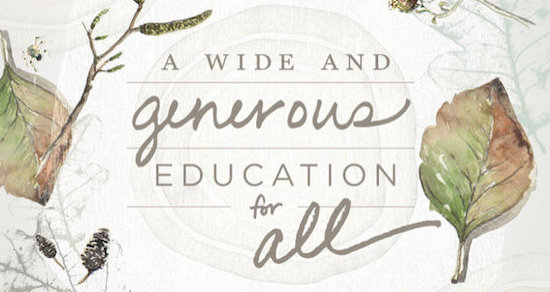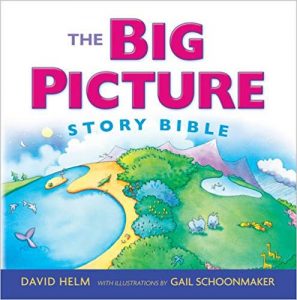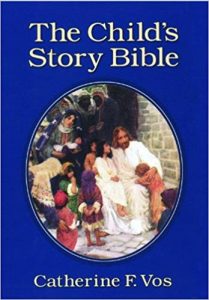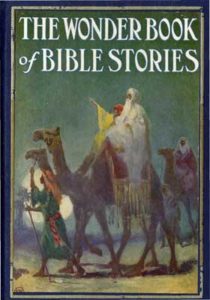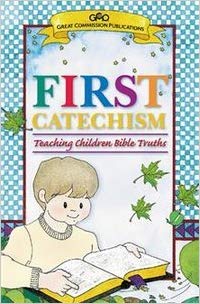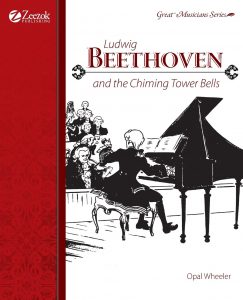Two roads diverged in a wood, and I—
I took the one less traveled by,
And that has made all the difference.
Robert Frost
You may be at a fork in the road, needing to make a decision for your child’s future. These are big decisions. Many parents hand off their child’s education because it’s just too hard to figure out, or they don’t feel capable. But in today’s circumstances, that may not be in your child’s best interest.
Starting anything new can be daunting, especially something as important as educating a child. What if I mess it up?! Take heart, the good news is it really isn’t rocket science. You can take it in pieces, line upon line, here a little, there a little, and sure enough, it will all begin to come together sooner than you think. It is a beautiful, worthwhile journey that an everyday person can not only manage, but learn to thrive on. With a little help, the process can be simplified and your path made sure.
Here are some tried and true resources from trustworthy sources to help you get started on the right foot. The purpose here is not to limit you, so if you see things elsewhere that are helpful – go for it! We’re simply here to direct you to what we know are good places to start.
General Homeschooling
Visit our general homeschooling information page here.
Statistics on Homeschooling
Can they get into college? Will they be socialized? If these things concern you, take a look at the results here and here to ease your mind.
Homeschooling Laws by State
You must abide by the laws in your state in order to homeschool. This can be simple or more involved depending on what state you live in. Find out what is required to homeschool in your state and also take time to talk to other experienced homeschoolers to help you with this step if you are feeling uncertain. HSLDA also offers membership for legal protection and is an organization that has been protecting homeschooling rights for years.
Start Learning
How we think about education affects how we go about teaching our children. Homeschooling offers us a lot more freedom of choice in educational methods and materials, which means it’s important to educate ourselves and make good informed choices. Think about the following questions: Will our students sit at a desk while we teach standing at the front of the room? Do we teach via lectures or a TV screen or by reading a book? How long, how much, and what should we teach? Do we use standard issue textbooks and workbooks or opt for the best books available? Many of us begin without a clear idea of the answers to these basic questions and many others that we may not have even thought of. That’s why it’s so eye opening to read and learn as you begin homeschooling. Even little moments of reading in a day, over time, can add up to a lot and go a long way in helping you form your ideas about what’s important to you as a teacher and why. Here are a few recommendations to help you get started.
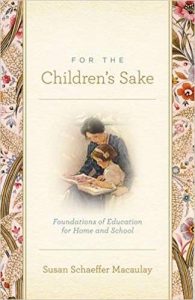
For the Children's Sake
The seminal book that brought Charlotte Mason's educational philosophy to the US.
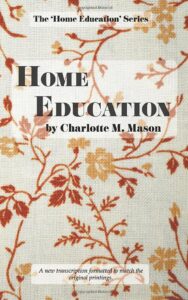
Home Education
The first volume of Charlotte Mason's Homeschooling Series. A great place to begin.
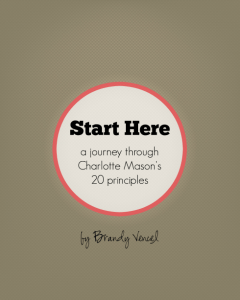
Start Here
Start Here is a guide to walk you through Charlotte Mason's 20 principles giving you a foundation of her educational philosophy.
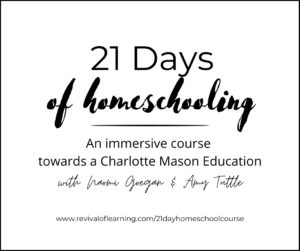
21 Days of Homeschooling
A self-paced immersive online course with Naomi Goegan and Amy Tuttle for homeschooling early elementary aged children.
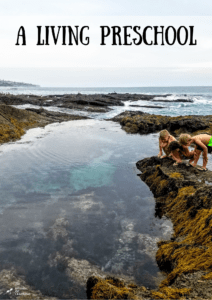
A Living Preschool Ebook
A complete guide to a Charlotte Mason Preschool in downloadable eBook format.
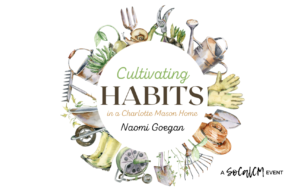
Cultivating Habits in a Charlotte Mason Home
A complete one hour session on why and how to establish habits as part of a Charlotte Mason education.
Curriculum
We … begin the definite ‘school’ education of children when they are six; they are no doubt capable of beginning a year or two earlier but the fact is that nature and circumstances have provided such a wide field of education for young children that it seems better to abstain from requiring direct intellectual efforts until they have arrived at that age.
~Charlotte Mason, Vol. 6
There are many curriculum choices out there in the Charlotte Mason sphere today; some are true to her methods, some are not, some aren’t even close! The AmblesideOnline curriculum is a tried and true Charlotte Mason curriculum and has been the gold standard from which many others have built alternate resources. Tens of thousands of families continue to use it around the world and it is the work of many people who have devoted their lives to researching and collaborating on Charlotte Mason’s ideas and methods. Many hundreds of volunteers have also contributed their time and effort towards updating and maintaining AO out of their love and appreciation for all it has done for their families. AmblesideOnline graduates have gone on to successful careers in many areas including the arts and sciences.
The following is an introductory video to the AmblesideOnline website. There are other helpful videos here to help you become familiar with their website and curriculum.
You can also find support and great discussions on various topics on the AmblesideOnline Facebook group and/or the AmblesideOnline Forum.
Additional Charlotte Mason Curriculum
The Charlotte Mason Educational Center (CMEC) is a nonprofit collaboration of parents and teachers dedicated to putting Charlotte Mason’s philosophy into practice.
Early Learning
A Formidable List of Attainments for a Child of Six
This is a brief but eye opening list from a curriculum outline of a Charlotte Mason school in the 1890’s here. It gives us an idea of what kinds of things early education worked towards and opens our modern eyes beyond ipad apps and jungle gyms in seeking to educate our own children.
- To recite, beautifully, 6 easy poems and hymns
- to recite, perfectly and beautifully, a parable and a psalm
- to add and subtract numbers up to 10, with dominoes or counters
- to read—what and how much, will depend on what we are told of the child
- to copy in print-hand from a book
- to know the points of the compass with relation to their own home, where the sun rises and sets, and the way the wind blows
- to describe the boundaries of their own home
- to describe any lake, river, pond, island etc. within easy reach
- to tell quite accurately (however shortly) 3 stories from Bible history, 3 from early English, and 3 from early Roman history (my note here, we may want to substitute early American for early English!)
- to be able to describe 3 walks and 3 views
- to mount in a scrap book a dozen common wildflowers, with leaves (one every week); to name these, describe them in their own words, and say where they found them.
- to do the same with leaves and flowers of 6 forest trees
- to know 6 birds by song, colour and shape
- to send in certain Kindergarten or other handiwork, as directed
- to tell three stories about their own “pets”–rabbit, dog or cat.
- to name 20 common objects in French, and say a dozen little sentences
- to sing one hymn, one French song, and one English song
- to keep a caterpillar and tell the life-story of a butterfly from his own observations.
CM Preschool & Kindergarten
In addition to the list above, we highly recommend you take the time to read more about Preschool and Kindergarten at the following links:
Home Education, Vol. 1 of the Charlotte Mason Series, Part V Lessons As Instruments Of Education p.169-199 (I. The Matter And Method Of Lessons, II. The Kindergarten As A Place Of Education, III. Further Consideration Of The Kindergarten)
For the Children’s Sake by Susan Schaeffer MacAualay
A Living Preschool – a practical guide for parents looking to lay a Charlotte Mason foundation for their children in their formative years.
Jewels of Astonishing Worth Series by Kathy Livingston
My Ideal Early Learning Program by Wendi Capehart
Laundry Preschool by Wendi Capehart
Math the Play Way by Wendi Capehart
Preschool and above books to read: https://amblesideonline.org/00bks.shtml
Favorite Picture Book Authors by Jeannette Tulis
More Books https://yesterdaysclassics.com/books/kindergarten/
Caitlyn Beauchamp’s Instagram and her articles at Afterthoughts – beautiful thoughts for preschool inspiration.
The Knowledge of God
Now our objective in this most important part of education is to give the children the knowledge of God. …the expressed knowledge attainable by us has its source in the Bible, and perhaps we cannot do a greater indignity to children than to substitute our own or some other benevolent person’s rendering for the fine English, poetic diction and lucid statement of the Bible.
Charlotte Mason, Vol. 6
From the earliest ages, we want to connect our children with the text of the Bible: God’s word. This is the most direct way for the Holy Spirit to speak to the child. If you’re not familiar with the bible, don’t let that stop you. AmblesideOnline has a listing of Bible stories by scripture under YR1 along with other short passages that can be read in the Old and New Testament in King James Version, or ESV. Other bible storybooks can be read as a supplement.
For our littlest ones we can share God’s word through simple retellings of bible stories.
Some families may choose to teach their children biblical truths through questions and answers known as the catechism. While this is not something Charlotte Mason taught, it is helpful in protecting children from the abundance of false teachings about the central truths of God’s word.
The importance of regular family church attendance in the life of your child can not be understated. At the same time, the “church” today has lost her bearings in many ways. Find a healthy church that aligns with a historic confession like the Westminster or Heidelberg.
Read Living Books
Not all books are the same. And just because a book is on the shelf doesn’t mean it’s good for your child. Everyone from politicians to activists to celebrities and TV producers are children’s book “authors” these days and after your child’s heart and mind. The article Grim Tales gives you a first hand look at the startling differences that exist within children’s literature. Please read it. You can also read the AO Living Books page to learn more about what a “Living” book is and isn’t.
Thankfully, there are trusted lists of books you can pull from in order to read to your child daily. Don’t settle for dumbed-down, or doctored tales. Children are smart and will step up to a consistent serving of quality if you would trust their able minds.
Leave them to think about the ideas rather than telling them what to think – chewing on ideas is good for them! Be their guide, not their tell-all. Attention span can be short at younger ages so keep readings short and stop at a cliff hanger and leave them wanting more rather than over doing it.
AmblesideOnline Year 0 Booklist – is a wonderful list of books that can be found at your library or online, many are available online for free.
Another List of Favorite Books
Librivox hosts volunteer read audio books and can be a helpful alternative when we are busy and we don’t want to put the kids in front of the TV, but don’t let it completely replace reading with your child. Some readers are wonderful! Others are not,. There is also a listing of the AmblesideOnline books available on Librivox
In the early days of a child’s life it makes little apparent difference whether we educate with a notion of filling a receptacle, inscribing a tablet, moulding plastic matter, or nourishing a life, but as a child grows we shall perceive that only those ideas which have fed his life, are taken into his being; all the rest is cast away or is, like sawdust in the system, an impediment and an injury.
Education is a life. That life is sustained on ideas.
Charlotte Mason, Towards a Philosophy of Education
Read a Poem a Day
To become intimate with poetry is a great enrichment of mind and instruction of conscience. In the early years the play on words and the cadence are an absolute joy.
This list of poems at AmblesideOnline for the younger years is an easy place to start. It is also available on Kindle.
Many other options are available on AmblesideOnline’s poetry page here.
Music
Sing together!
“…singing … is a deeply human endeavor. There are illiterate cultures. There are no cultures I have heard of with no music.” ~Wendi Capehart
While it may not be something you’re used to doing in your family, music and singing are part of our human history and cultural past; an inheritance for every child.
In just a few minutes a day, we can make sustaining music a part of our children’s lives. Begin with an easy hymn, like Jesus Loves Me This I know, This is My Father’s World, Holy, Holy, Holy. Learn a folk song. Folks & Hymns has many songs to sing along to. Incorporate classical music into your child’s day. Prokofiev’s Peter and the Wolf is a great place to start, also Benjamin Bitten’s Young Person’s Guide to the Orchestra. Music apps like Spotify allow you to search by artist, which brings up many of their songs. You can find a list of composers at AmblesideOnline.org.
To learn more about different composers you can listen to Classics for Kids, it is also available as a podcast. Each episode lists the music played so you can look up what you enjoy and play the full-length pieces.
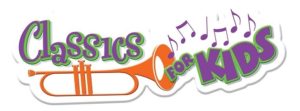
Acapella Hymns pairs music with lyrics to help learn hymns.
Folks & Hymns also has acapella recordings of many of the AmblesideOnline hymns (check the tags at the bottom of the page.)
Opal Wheeler books are wonderful biographies of composers.
Music at Home has free composer study lessons that are helpful for mom to know what to teach. Keep in mind littles need short lessons so don’t over-do it with little ones. Dry, lengthy lessons too early can hinder the love of music.
Fingerplays are also fun for little ones. And here.
Spend Time in Nature
Getting outside in the fresh air and letting your children have long hours playing in natural spaces is invaluable to their growth and learning. Nature provides endless nourishment for our senses, our well being, and stores of knowledge of real things and wonder for the scientific years to come. Plus, a child who has spent time outdoors is more likely to be content playing restfully later in the day and will get a better night’s sleep. Begin to collect durable, quick reference guides to bring with you to allow your little ones to see if they can find what they saw: birds, wildflowers, seashore life, etc.
Get a bird feeder, visit the creek, or check local state and regional parks in your area. Even just walking down your street every day will expose children to weather, trees, sky, insects, birds and more and is worthwhile.
Look at timeless art together
A picture speaks a thousand words. While our modern idea of children’s art can direct us towards cartoons and dumbed down images, a child is capable of enjoying a beautiful painting and their minds should be allowed to perceive what is beautiful and complex and abiding.

By Albert Bierstadt – 1. forum.netfotograf.com 2. Google Art Project works from the Birmingham Museum of Art, Public Domain, Link
You can also find a list of artists and selections here. Spend a few minutes every other week looking at one work of art together. Don’t worry about critically evaluating it or knowing anything about art, just look and wonder together. Ask each child to look at it for a minute or two, cover it, then have them tell you what they remember about it. What it made them think about. If it reminded them of anything. You can read more about Charlotte Mason’s ideas on art here. You can find formatted files of the AmblesideOnline art prints and biographies of artists at ahumbleplace. These files can be submitted online to Staples, Office Max, etc. for low cost color prints.
Establishing Habits for LIfe
Homeschooling comes on quickly and before you know it you’ll be in the thick of it. Start early and teach your children how to take care of themselves, their things, and respect others. Teach your children to make their beds, fold their clothes, line up their shoes, help set the table, clean their dishes – the daily things of life. Take a look around their spaces and see how you can help them better succeed at these basic tasks. Focus on one thing at a time and once a habit is established you can work towards establishing another.
Have quiet times in the home without any electronics – let them get bored! – so they learn to be creative and content with very little, without constant entertainment. Teach children the difference between “I want” and “I will.” We may not always want to do what’s right, but we can choose to. Leaving a child to his every whim enslaves him to his emotions and poor habits that will ultimately rule over him unless he is taught how to govern himself. Like a muscle, he must exercise his ability to choose to do what is right even when he may not feel like it. Learn more about habits in the early years in the audio download Habits in a Charlotte Mason Education and A Living Preschool, and beyond in these posts here and here.
A good curriculum will also help your child learn to consider right from wrong and provide the needed inspiration and character study to develop discernment.
“…to give a child this power over himself––first in response to the will of another, later, in response to his own, is to make a man of him.” Vol 3, pg 20
Charlotte Mason had a motto for her students to teach them: I am, I can, I ought, I will.
You can read more about habits and Charlotte Mason’s ideas on Education is a Discipline here, here, here, and here.
Keep Learning
There are additional resources available for you to keep learning and fine tuning as you walk down this road of faith with your children.
“Like the quality of mercy, it is not strained; certainly it is twice blessed, it blesses him that gives and him that takes, and a sort of radiancy of look distinguishes both scholar and teacher engaged in this manner of education…”
“Let me try to indicate some of the advantages of the theory I am urging––It fits all ages, even the seven ages of man! It satisfies brilliant children and discovers intelligence in the dull. It secures attention, interest, concentration, without effort on the part of teacher or taught.”
“Children, I think, all children, so taught express themselves in forcible and fluent English and use a copious vocabulary. An unusual degree of nervous stability is attained; also, intellectual occupation seems to make for chastity in thought and life. Parents become interested in the schoolroom work, and find their children ‘delightful companions.’ Children shew delight in books (other than story books) and manifest a genuine love of knowledge.”
“Teachers are relieved from much of the labour of corrections. Children taught according to this method do exceptionally well at any school. It is unnecessary to stimulate these young scholars by marks, prizes, etc.”
“After all, it is not a quack medicine I am writing about…”
Find Community
Finding like-minded families and community, while not essential, can be a great source of encouragement. Reading and study groups are also a great way to learn and process. Even if it’s one other mom to talk with while the kids play or to read a book with, connecting with others has its benefits. Visit our Community Page here to connect.

